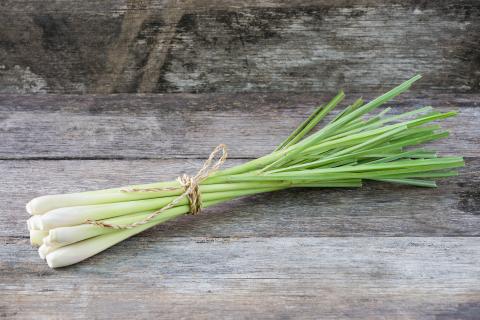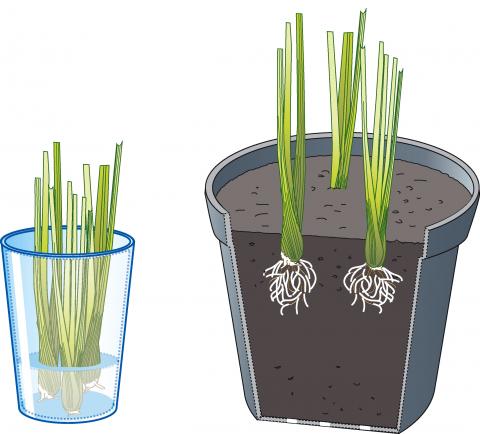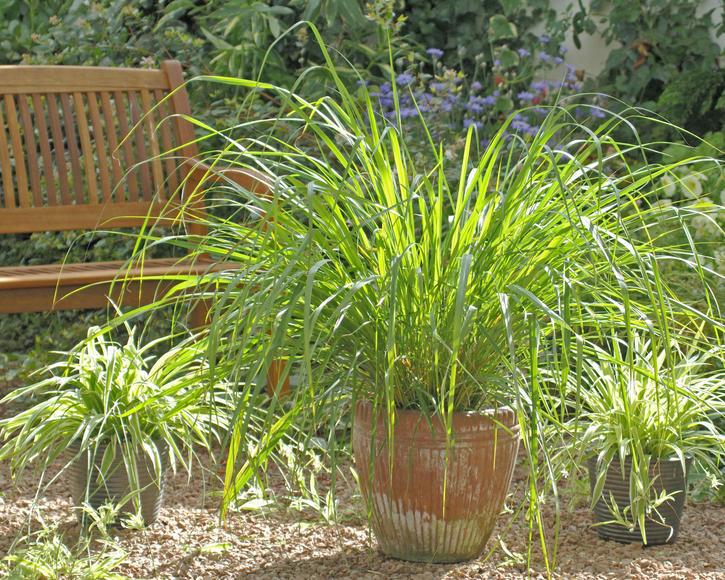Lemongrass
Lemongrass is a popular flavor in Asian cuisine. It is not winter hardy at temperate latitudes, but can be cultivated as a potted plant or houseplant – it can even spend summers in outdoor beds.
Factsheet
- Growth type
-
- Grass
- Growth characteristics
-
- horst-forming
- Flower characteristics
-
- unimpressive
- Fragrance
-
- 3
- Leaf color
-
- green
- page format
-
- grassy
- long
- linear
- Sheet properties
-
- evergreen
- Light
-
- sunny
- Soil Moisture
-
- fresh to humid
- Nutrient requirements
-
- nutrient-rich
- Humus
-
- rich in humus
- Decorative or utility value
-
- Leaf ornaments
- medicinal plant
- Toxicity
-
- non-toxic
- Winter Hardness
-
- frost-sensitive
- Use
-
- Planters
Cut into fine rings, the thick stalks of the lemongrass (Cymbopogon citratus) plant have a slightly peppery taste with a subtle citrus aroma and a hint of coriander. This is used to give Thai curries and other Asian dishes an exotic aroma. Fresh lemongrass tastes especially intense, with the dried alternative being a poor replacement. You can buy fresh lemongrass in most world food stores but you can also easily grow this flavorsome grass yourself.
The lemongrass genus comprises 56 species, most of which are perennials. They naturally grow in the tropics and in warmer, temperate areas of Asia and Europe. Some, such as Cochin grass (Cymbopogon flexuosus) or gingergrass (Cymbopogon martinii), are primarily used in the perfume industry. West Indian lemongrass (Cymbopogon citratus), a clump-forming grass that forms dense, sturdy stalks, and is especially popular thanks to its aromatic flavor. Up to 35 inches tall, the linear gray-green evergreen leaves hang slightly and give off a subtle citrus aroma. This species primarily, of course, grows in southern India and Sri Lanka, and is not winter hardy in temperate zones. Nevertheless, this member of the grass family (Poaceae) can be grown here as long as it is brought into the house before the first frost.
Alongside its use in Asian cooking, West Indian lemongrass is also used in the cosmetics industry in soaps, hair oils and perfumes among other products. It is also a popular medicinal plant with sweat-inducing, anti-spasmodic, antibacterial and soothing effects. Due to its digestion-supporting properties, lemongrass tea is a popular treatment for disorders of the digestive system. But it also has a cooling effect.

Whether it’s planted in a pot or in a bed, lemongrass prefers a warm and protected location in the garden, either in a bed next to a wall or a position on a terrace where it’s protected from the wind. The location should also be sunny if possible. If you’d instead like to grow lemongrass indoors, you should find a bright sunny place for the plant, such as a windowsill at the south of the building. Lemongrass is most likely to thrive when the air is dry – which makes it very easy to cultivate indoors in winter as heated air tends to be dry.
West Indian lemongrass also has a few requirements when it comes to soil. It should ideally be very nutrient-rich, humus-reach and deep as well as permeable and always fresh to slightly moist.
Due to its low level of winter hardiness, lemongrass is generally kept in containers here. It can also be planted in beds over summer but has to be removed and taken indoors in fall as it will not tolerate temperatures of less than 44 degrees Fahrenheit. When the plant is allowed back outdoors in spring, this is the ideal time to pot it on into a larger container. Regular pruning is carried out by way of harvesting. This is important, as it encourages growth and ensures that the plant forms nice, dense clumps. If some leaves turn yellow, these should be removed quickly.
A good water supply is essential in ensuring that lemongrass thrives. In summer, the plant’s main growing phase, it should be watered generously three times a week as it prefers fresh to moist soil. Waterlogging should be avoided at all costs, as this plant’s roots will inevitably start to rot. Over the winter months, water may be given every two to three weeks. In its main growth phase, lemongrass can be fed with an organic fertilizer once a month, e.g. nettle manure, coffee grounds or – for long-term soil nutrition – horn shavings worked into the substrate in spring.

Lemongrass tastes most intense when it’s freshly harvested and used right away. But it will keep in the refrigerator for up to 14 days wrapped in a little wet kitchen paper. It is mostly harvested in the summer months as the plant will eagerly form new stems. Only the lower part of the stem is used in cooking (identifiable by its white coloring), as the upper part is very fibrous. As the stems are very hard, you should use a sharp knife to harvest them. Cut the stems directly above the root, making sure not to damage or squash the heart of the plant. The white part of the plant that can be used in cooking is around 3.94 inches long. You can simply remove the green top to be composted.
Lemongrass is not difficult to propagate. Just buy a couple of lemongrass stalks from a world food store that are still juicy at the base, and place them in a glass with around 0.39 to 1.18 inches of water. The stalk will begin to sprout white rootlets after one to two weeks. Plant the stalks in 0.79 to 1.18 inches of herb or potting soil and keep the substrate slightly moist at all times. Once the first new leaves appear, you can plant the stalks in larger pots. After around three months, when the stems have thickened considerably, you can begin to harvest from the new plant. If you already have a lemongrass plant, you can easily propagate it by separating it – as is possible with most other grasses. As cultivated lemongrass does not flower, it is not possible to propagate it through seeds.

The most common pest found on West Indian lemongrass is the dark-winged fungus gnat, whereby it is not the small black flies that do the damage, rather their larvae. These normally reside in the soil but can enter the plant through the smallest of injuries. The result is growth damage, which is particularly difficult for young plants to overcome. You can prevent infestation: dark-winged fungus gnats love damp soil, so do not overwater young plants. If your plant is already infected, the addition of sticky gnat traps can help.


